The Best Italian Movies – TOP 20 Italian Films
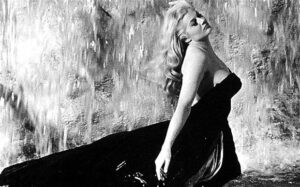
Cinema owes Italy many great masterpieces. Indeed, this country has produced such great directors as Rossellini, Fellini and De Sica.
The first Italian film was Italo Pacchioni’s “The Arrival of the Train at Milan Station”, modeled on the famous Lumiere brothers’ picture. On the other hand, feature cinema was initiated by Giuseppe Filippi’s “Diana’s Bath”. Both pictures were made in 1896, albeit under the aegis of the French Lumiere studio. Soon, however, indigenous film companies began to emerge in major metropolises such as Rome, Milan, Turin and Venice. The most important trend of Italian silent cinema was monumentalism. It consisted of realizing impressive historical spectacles depicting the ancient era. The most famous work of this kind was “Cabiria” (1914) by Giovanni Pastrone. With the production of movies gaining international popularity, the institution of the “diva” – the beautiful, beloved actress – was born. Among the most famous stars were Francesca Bertini or Soava Gallone.
When Benito Mussolini took power in the 1920s, the LUCE label was established, specializing in documentary propaganda cinema. From then on, filmmakers lost their artistic freedom, and a trend that focused on banal everyday problems in order not to expose themselves to the authorities was the so-called “white telephone cinema.” In 1936, the Italian film town of Cinecita, Italy’s largest film studio, was built in the suburbs of Rome. At the same time, despite the censorship measures, it was possible to produce outstanding works, as exemplified by the work of Alessandro Blasetti and Mario Camerini.
Italian films – from the wartime to the present day
Already the end of the 1930s resulted in the emergence of one of the most famous Italian film trends, namely Neorealism. It was characterized by an interest in social problems and a documentary style. The most important work of neorealism was “Rome, Open City” (1945) by Roberto Rossellini. In turn, notable directors of this direction include such filmmakers as Vittorio De Sica, Luchino Visconti and Giuseppe De Santis. The 1950s also saw the birth of the great auteur cinema of Michelangelo Antonioni and Federico Fellini. The next decade, meanwhile, brought the films of contortionists and rebels, such as Pier Paolo Pasolini, Bernardo Bertolucci, brothers Paolo and Vittorio Taviani and Marco Ferreri.
Popular genres of Italian cinema of the following decades of the 20th century, meanwhile, were horror films and spaghetti westerns. Of great interest as far as horror cinema was concerned were the so-called giallo films, in which Dario Argento specialized with his famous “Suspiria” at the forefront. On the other hand, an important novelty occurred in the 1990s, when such filmmakers as Pupi Avati, Giuseppe Tornatore and Gianni Amelio came to prominence. In 2001, the son of the older generation director Nanni Moretti’s Room was a huge success. He became the champion of the next generation of filmmakers who focused on political cinema, making films about the Italian mafia in particular, such as Matteo Garrone’s high-profile movie.
The best Italian movies of all time
1. ”Cabiria” (1914)
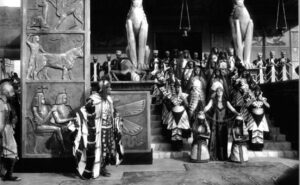
“Cabiria” is a famous film by Giovanni Pastrone from 1914. The work represents the trend of cinema known as Italian monumentalism. “Cabiria” is set during the wars between Scipio of Africa and Hannibal in the 3rd century BC. The title character (played by Giulietta Masima) is the daughter of a Roman patrician kidnapped by the Carthaginians during the eruption of Etna. The film tells the story of her amazing adventures, and has gone down in history for its tremendous panache in staging the historical spectacle using stunning outdoor locations.
The plot is multi-layered and takes place over many years. Pastrone was the first in the cinema to shoot shots in the authentic outdoors, hence in the film you can see the snowy Alps, the sea or deserts. Moreover, elephants, camels, horses and even a leopard were involved in the production. The scenery could make the viewers of the time dizzy, with monumental styling of ancient buildings, temples and dungeons.
2. “Paisa” (1946)
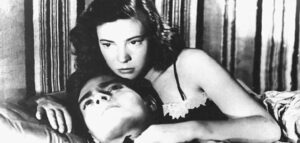
“Paisa” is a 1946 work by Roberto Rossellini. The movie is one of the most important works of Italian neorealism. The film is set at the end of World War II and centers around the liberation of Italy by the Allies. The title of Rossellini’s film was taken from wartime realities, it was a phrase used by the Americans against the local population.
The movie shows wartime Italy from the point of view of the Americans entering the country, which broadens and enriches the view of that reality. The film gives the impression of a realistic chronicle, showing the suffering of a nation in the face of a difficult history. “Paisa”, along with “Rome, Open City” in the eyes of Italians, became a monumental testimony to their collective experience.
3. “Bicycle Thieves” (“Ladri di Biciclette”,1948)
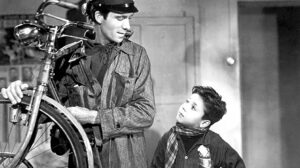
Vittorio De Sica’s “Bicycle Thieves” is another example of cinematic neorealism. The simple story about a man who, along with his son, searches for his stolen bicycle is an excuse to show post-war Italy, with a distinct hint of sentimentality. The film stars Lamberto Maggiorani and Enzo Staiola in lead roles.
De Siki’s film is a moving social cinema to this day, in solidarity with the suffering of the simple, poor man. One of the most important Italian films that cannot be ignored in reflecting on the country’s national cinema.
4. “La Strada” (1954)
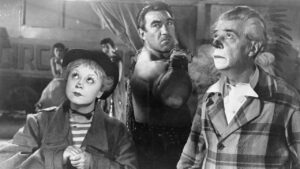
“La Strada” is one of Federico Fellini’s flagship works. The film is the moving story of two itinerant circus performers: Gelsomina (Giulietta Masima) and Zampano (Anthony Quinn). The relationship that unites them becomes an opportunity for the director to make a statement about love, passing and the stigma of guilt.
Almost every Fellini film is a masterpiece, hence it is very difficult to single out those that should be particularly distinguished. “La Strada” is a work in which the director presents a kind of philosophy guiding his work. Its most important point seems to be the belief in the cleansing power of love, which like sea waves can wash the culprit of the worst deeds.
5. “Rocco and His Brothers” (“Rocco e i suoi Fratelli”,1960)

“Rocco and His Brothers” is a masterpiece by Luchino Visconti. The film tells the story of the breakup of a Sicilian family that emigrates for work and a better life to the northern part of Italy. Visconti’s work refers to Thomas Mann’s great tetralogy Joseph and his brothers. The main character was played by Alain Delon, and alongside him in the film were Renato Salvatori, Annie Girardot and Claudia Cardinale.
This is a work that was shot with great ambition, as it is guided by the idea of showing a generational change in Italy. The tradition represented by the matron of the family collides with modernity and the dangers of the big city. The past must confront the future, and the young protagonists must make a not easy choice of their life path.
6. “8 ½” (1963)
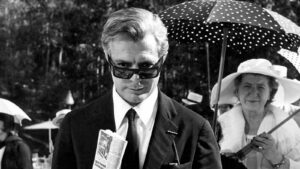
“8 ½” is another work by Fellini, which is considered by many critics to be the director’s most outstanding film. The picture is autobiographical in nature, and tells the story of the creative impotence of the famous filmmaker Guido (played by Marcello Mastroianni). A significant performance in “8 ½” was also presented by Claudia Cardinale.
Referring to Thomas Mann’s “The Magic Mountain”, the work is a kind of attempt to sum up the oeuvre of the creator, who, like the main character, looks back on his life’s achievements, relationships and values to ask whether there is any hidden meaning in it all.
7. “The Gospel According to St. Matthew” (“Il vangelo secondo Matteo”,1964)
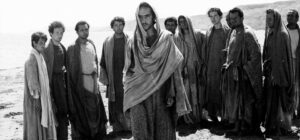
Pasolini’s “The Gospel According to St. Matthew” was based on the biblical text of the second evangelist. However, the director reinterpreted the original, exposing the figure of Christ as a revolutionary establishing a new social order. The film is distinguished by its artistic qualities, such as the combination of classical music with African sounds and numerous references to Renaissance painting. Interestingly, Pasolini cast his own mother, Susana Pasolini, in the role of the Virgin Mary.
8. “Blow Up” (1966)
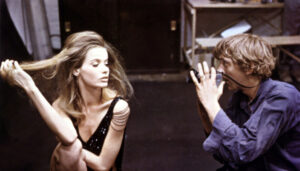
“Blow Up” is one of Michelangelo Antonioni’s best movies, made in Britain. The main character of the work is a young fashion photographer, Thomas (played by David Hemmings), who accidentally captures in a photograph the murder of a man in a park. The film starred Vanessa Redgrave, Sarah Miles and the famous model Veruschka, among others.
The issues raised by Antonioni in this film are extremely rich. Here the director asks surprisingly topical questions about the status of truth in the world of media creating current reality. He also aims to draw a portrait of the generation of contestation of the late 1960s.
9. “Death in Venice” (“Morte a Venezia”, 1971)

“Death in Venice”, Visconti’s classic, has as many lovers as opponents. The film is a loose adaptation of a short story by Thomas Mann. The main character of Visconti’s picture is an aging famous composer who arrives in Venice to recuperate. Experiencing a creative crisis, Gustav von Aschenbach (Dirk Bogarde) falls in love with a young Pole, Tadzio (Bjorn Andresen).
Visconti’s work is an extended and profound reflection on art, which turns out to be as delightful as it is demonic, as it requires the creator to sell his soul to the devil. The decadent mood is given to the painting by the omnipresent death, which is the ultimate effect of every action, including love. The raging pestilence also leads to the dying of the city itself – a metaphor for European culture.
10. “Last Tango in Paris” (“Ultimo tango a Parigi”, 1972)

“Last Tango in Paris” is Bernardo Bertolucci’s acclaimed film. The work is the story of a sadomasochistic love affair between an aging American man Paul (played by Marlon Brando) and a young French woman Jeanne (Maria Schneider). The film is a multi-level picture in which literary, philosophical and, above all, psychoanalytic inspirations intermingle.
Bertolucci’s title is a testament to Italian cinema’s gradual shift away from political themes and toward portraying individual fates, especially the generation of rebellion and moral change.
11. “Padre Padrone” (1977)
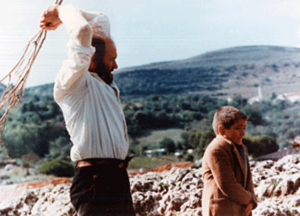
In the “Padre Padrone” by the Taviani brothers is a beautiful film based on the biography of Gavino Ledda, an Italian linguist. The work presents a difficult childhood and the adversity-filled journey of the main character (Saverino Marconi) to realize his dreams. In the power of the father is a film about the clash of family roots and one’s own vision of the world in the life of each person, and the great value of each of these reasons.
Tavianich’s film is also an extremely profound portrait of Sardinia – with its magnificent nature and the rhythm of life subject to the laws of nature. The sounds, as well as the silence, the symbolism of the image and the varied colors play an important role here.
12. “A Leap in the Dark” (“Salto nel vuoto”, 1980)
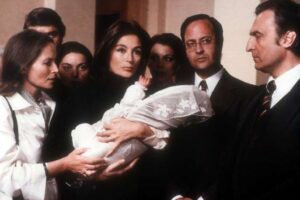
Marco Bellocchio’s “ A Leap in the Dark” is a 1980 Italian film. It depicts the story of the complicated family relationship of brother and sister Mauro Ponticelli (Michel Piccoli) and Marta (Anouk Aimee). The film demythologizes the institution of the family, exposing the truth about the often cruel and full of hidden aggression blood ties. Both the actors playing the main roles were awarded at the Cannes Film Festival.
The movie is clearly part of psychological cinema, but also part of the current of contestation in Italian cinema. The family becomes a breeding ground for various pathologies and, instead of supporting the individual, can become the cause of his or her lifelong confusion.
13. “Cinema Paradiso” (1988)
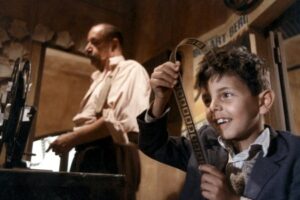
“Cinema Paradiso” by Giuseppe Tortnatore is one of the most famous Italian movies. The work tells the story of growing up a boy, Toto, whose greatest passion is cinema. The protagonist spends a lot of time at the local Paradiso cinema, where he befriends cinematographer Alfredo (Philippe Noiret). The roles of Toto are played by Salvatore Cascio and Marco Leonardi.
Tornatore’s extremely moving picture is undoubtedly one of the most outstanding Italian films. The story of a provincial town here becomes the history of cinema and of Italy as a whole.
14. “Lamerica” (1994)
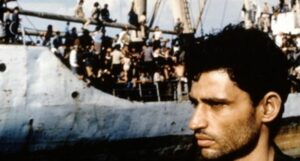
“Lamerica” by Gianni Amelio is a great film about two Italian mafiosi (Gino and Fiore) who try to make a profitable but fraudulent business in Albania. Nothing goes according to plan, however, and exposure to a different culture and extreme poverty results in Gino’s transformation. The film stars Enrico Lo Verso and Michele Placido in lead roles.
Amelio’s movie touches on relevant topics in Italy, such as the refugee issue, the job search and the crisis in family relationships.
15. “Mediterraneo”, 1991
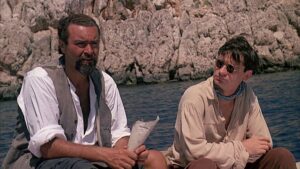
Gabriele Salvatores’ 1991 masterpiece cannot be missing from the list of best Italian movies. Mediterranean Idyll is set during World War II on one of the Greek islands. Italian soldiers sent there are tasked with defending the territory from the enemy, but in a place cut off from the world nothing actually happens. So, deprived of war fervor, the men indulge in the available pleasures and don’t even notice when the war comes to an end.
Savatores’ picture, which won an Oscar for Best Foreign Language Film, belongs to a tetralogy, the other parts of which are “Marrakech Express” (1989), “Tournée” (1990) and “Puerto Escondilo” (1992). The individual parts are united, among other things, by the character of the actor – Diego Abatantuono – and by the subject matter. Namely, it is the theme of avoiding life’s responsibilities.
16. “The Postman” (“Il Postino”, 1994)
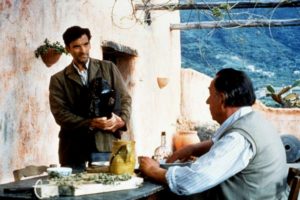
Another Italian Oscar winner, “The Postman”, directed by Michael Radford. This is the story of a man who is hired as a private letter carrier. He is to be in charge of delivering correspondence to a famous Chilean poet, Pablo Neruda (Philippe Noiret). After all, the writer is settling in southern Italy after being forced to emigrate. Thanks to this acquaintance, Mario himself discovers a literary talent and begins to write poems. In turn, the relationship established with the writer completely changes his view of the world.
“The Postman” was the last movie in which Massimo Troisi (who played the main role) starred. Moreover, the filmmakers, after his death, decided to recognize the actor’s contribution and acknowledge him as co-director of the picture.
17. “Life Is Beautiful” (“La vita è bella”, 1997)
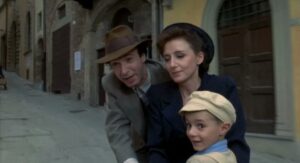
One of the most famous Italian films – “Life is Beautiful” by Roberto Benigni. It is a remarkable story about the attempt to preserve humanity in the inhumane conditions of a concentration camp during World War II. Guido, who ends up there with his son, convinces him that everything going on around him is just a game in which you have to follow certain rules. Lined with a comedic touch, Benigni’s work caused a lot of controversy due to the gap between the moody convention and the tragic theme of the Holocaust.
However, this did not prevent Benigni’s title from winning major film awards: three Oscars, the Cannes Jury Prize and the European Film Award. The leading role was played by the director himself, with his wife played by Nicoletta Braschi and his son by Giorgio Cantarini.
18. “The Great Beauty” (“La grande bellezza”, 2013)

Paolo Sorrentino’s film “The Great Beauty” also proved to be a huge international success for Italian cinema. The Oscar-winning picture tells the story of a journalist who, while walking around Rome, recalls his life and past youth. The lead role was played by Toni Servillo.
“The Great Beauty” is a clear reference to Federico Fellini’s famous “Dolce vita“, and the main character has much in common with the character created by Marcello Mastroianni. The sacred neighbors here with the profane, the ugly with the beautiful, and empty hedonism with the search for the meaning of life.
19. “The Son’s Room” (2001)

“The Son’s Room” is a Italian film directed by Nanni Moretti. The work is the story of a family experiencing drama after the death of their son. In addition to the director himself, who plays the role of a distraught father, the film stars Giuseppe Sanfelice and Laura Morante. Moretti’s work was awarded the Palme d’Or at the Cannes Film Festival.
20. “Gommorah” (2008)
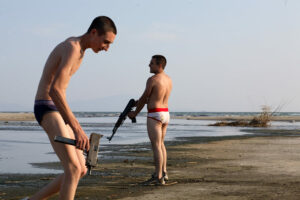
The “Gomorrah”, directed by Matteo Garrone, is a free adaptation of Roberto Saviano’s novel of the same title. The film tells the story of the Italian mafia (camorra) and its criminal activities. Garrone shows the mechanisms of gangster clans through the prism of the fate of several residents of Naples.
It is worth mentioning that until Gomorra, the most important film about the Neapolitan Mafia was 1986’s “Il camorrista”, directed by Giuseppe Tornatore.
